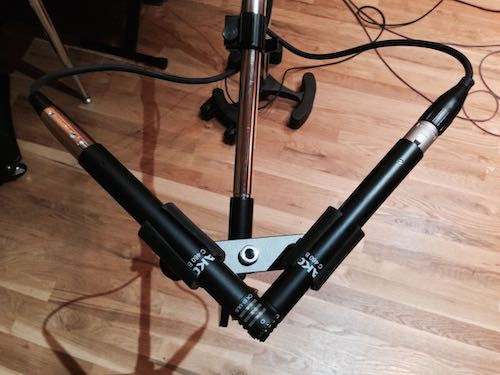Exploring Micing Techniques for Recording Acoustic Guitars
- David Williamson Pichard

- Jun 27, 2023
- 3 min read
When it comes to capturing the natural and captivating sound of an acoustic guitar during recording sessions, choosing the right micing technique is crucial. In this blog post, we will dive into the pros and cons of four commonly used micing techniques: Mid-Side, Close-Micing, X-Y Stereo, and Room Micing. Each technique offers a unique approach to capturing the essence of the instrument, and understanding its characteristics will help you make an informed decision for your next recording session.
1. Mid-Side Micing Technique:

The Mid-Side micing technique involves the use of two microphones—one positioned directly in front of the acoustic guitar (the Mid microphone) and the other positioned perpendicular to it (the Side microphone). This technique allows for precise control over the stereo width during mixing.
Pros:
- Excellent stereo imaging: Mid-Side micing captures a wide and detailed stereo image of the acoustic guitar.
- Adjustable stereo width: The ability to adjust the stereo width during post-production gives you flexibility in shaping the sound.
Cons:
- Complexity: Setting up and mixing the Mid-Side micing technique requires technical expertise and precise microphone positioning.
- Phase issues: Improper microphone placement can lead to phase cancellation, resulting in a hollow or unnatural sound.
2. Close-Micing Technique:

Close-micing involves placing a microphone in close proximity to the soundhole or the fretboard of the acoustic guitar. This technique emphasizes capturing the direct sound of the instrument.
Pros:
- Focus and clarity: Close-micing provides a detailed and focused representation of the acoustic guitar's sound.
- Minimized room ambiance: By reducing the pickup of room reflections, close-micing allows for greater control over the instrument's sound.
Cons:
- Lack of natural ambiance: Close-micing may result in a more intimate and isolated sound, potentially lacking the natural room ambiance.
- Imbalance in low frequencies: Placing the microphone too close to the soundhole can result in an overpowering low-end response.
3. X-Y Stereo Technique:

The X-Y Stereo technique utilizes two microphones positioned closely together at a 90-degree angle, capturing the acoustic guitar's sound from a single point in space.
Pros:
- Accurate stereo representation: X-Y Stereo micing provides a balanced and accurate stereo image of the acoustic guitar.
- Reduced phase issues: The close proximity of the microphones minimizes phase cancellation problems.
Cons:
- Narrow stereo field: Compared to other techniques, the stereo image produced by X-Y Stereo micing may sound narrower.
- Less depth and spaciousness: This technique might not capture the full depth and spaciousness of the acoustic guitar in certain recording environments.
4. Room Micing Technique:

Room micing involves placing one or more microphones at a distance from the acoustic guitar, capturing the instrument's sound as it interacts with the surrounding room.
Pros:
- Natural ambiance: Room micing captures the fullness and natural ambiance of the acoustic guitar, adding depth and spaciousness to the recording.
- Immersive sound: This technique can provide a sense of space, enhancing the listener's experience.
Cons:
- Room acoustics: The quality of the room's acoustics plays a significant role in the final recording, and an unsuitable room may introduce unwanted reflections or resonances.
- Background noise: Depending on the recording environment, room micing can pick up undesirable background noise that may require additional noise reduction during post-processing.
Conclusion:
Selecting the appropriate micing technique for recording acoustic guitars depends on the desired sound, the recording environment, and the creative vision of the producer or engineer. Each technique discussed—Mid-Side, Close-Micing, X-Y Stereo, and Room Micing—offers distinct advantages and limitations. These are not the only techniques out there but are some of the more common approaches used with acoustic guitar recordings.
Experimenting with different micing techniques will allow you to discover the approach that best captures the unique character and sonic qualities of your acoustic guitar, resulting in an engaging and authentic recording.
Remember, mastering the art of recording an acoustic guitar takes practice, patience, and an ear for detail. Take the time to experiment with different micing techniques, and don't be afraid to trust your ears. Happy recording!



Comments